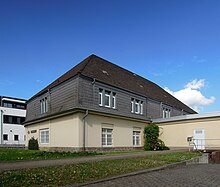Infantry barracks Eschweiler
The former infantry barracks Eschweiler can be found in the center of Eschweiler in the North Rhine-Westphalian city region of Aachen . The buildings along Gartenstrasse and Preyerstrasse are used today by companies, the Eschweiler municipal high school and the police.
Today's Preyerstraße was called Kasernenstraße until 1955 , at times Hindenburgstraße , and in the 19th century it was called Lohner Straße .
history
From 1907 on, the Eschweiler city council and especially Mayor Ludwig Carbyn endeavored to make Eschweiler a garrison town. Carbyn's successor Carl Hettlage continued the efforts after his death in 1910. The Berlin War Office chose Eschweiler ultimately plant one infantry battalion , told this to the city council on September 14, 1912 and the barracks emerged from 1913 to 1914 on the former Stürtz'schen land on the "Come" Today corner Gartenstraße / Preyerstraße on a Area of 3½ hectares under the direction of city architect Geis. The foundation stone was laid on April 12, 1913 and the topping-out ceremony on November 3. The built-up area was 6,713 square meters. The officers' mess was 200 to 300 meters away on the corner of Gartenstrasse and Parkstrasse . At the same time, a military hospital was built in the Eschweiler St. Antonius Hospital .
The team houses faced Gartenstrasse , and the staff building, civil servants' house, NCO's family house and chamber building faced today's Preyerstrasse .
On July 1, 1914, four companies of the 2nd Battalion of Infantry Regiment 161 (10th Rheinisches) from Trier with a strength of 722 men moved in that afternoon. Shortly afterwards, at midnight from August 5th to 6th, 1914, the soldiers had to go to the front because the First World War had begun.
After World War II, the demilitarization of the carried Rhineland and the Allied occupation of the Rhineland . On November 16, 1918, five days after the armistice was signed, the 240 infantry regiment was ceremoniously received in the barracks, and on November 24 the Eschweiler garrison withdrew. The Eschweiler barracks was occupied on December 5, 1918 by the 169th French infantry regiment, which was relieved by Belgian troops in June 1919 . The withdrawal of the last occupation troops from Eschweiler on November 5, 1929 was accompanied by a great liberation ceremony with bonfires around the city.
From November 1919 to August 1921, the so-called "Moroccans" were stationed in Eschweiler is just 1 he Régiment Mixte of Zouaves et sharpshooters. Soldiers of this regiment shot and killed the factory worker Jakob Koch and the police sergeant Karl Schmitz, who rushed to his aid , on June 2, 1920 near the Eschweiler main station . The gunmen were acquitted on October 13 by a French court martial .
When separatists hoisted the flag of the Rhenish Republic in Eschweiler on October 16, 1923 , the city was in a state of emergency for two weeks. On November 2nd, the Belgian occupation forces expelled the putschists.
The officers' mess was demolished after the Second World War and residential buildings for military employees of the Bundeswehr were built in its place .
See also
Other barracks in the Eschweiler urban area are the Donnerberg barracks of the Bundeswehr and the former Camp Astrid of the Belgian armed forces .
photos
literature
- Eschweiler in old views (Ed. Eschweiler Geschichtsverein ), 1979, pp. 28-29 < ISBN 90-288-2944-X >
- Eschweiler in old views, Volume 2, (Ed. Eschweiler Geschichtsverein ), 1999, pp. 20-22 < ISBN 90-288-6572-1 >
Coordinates: 50 ° 49 ′ 20.4 " N , 6 ° 16 ′ 37.2" E





